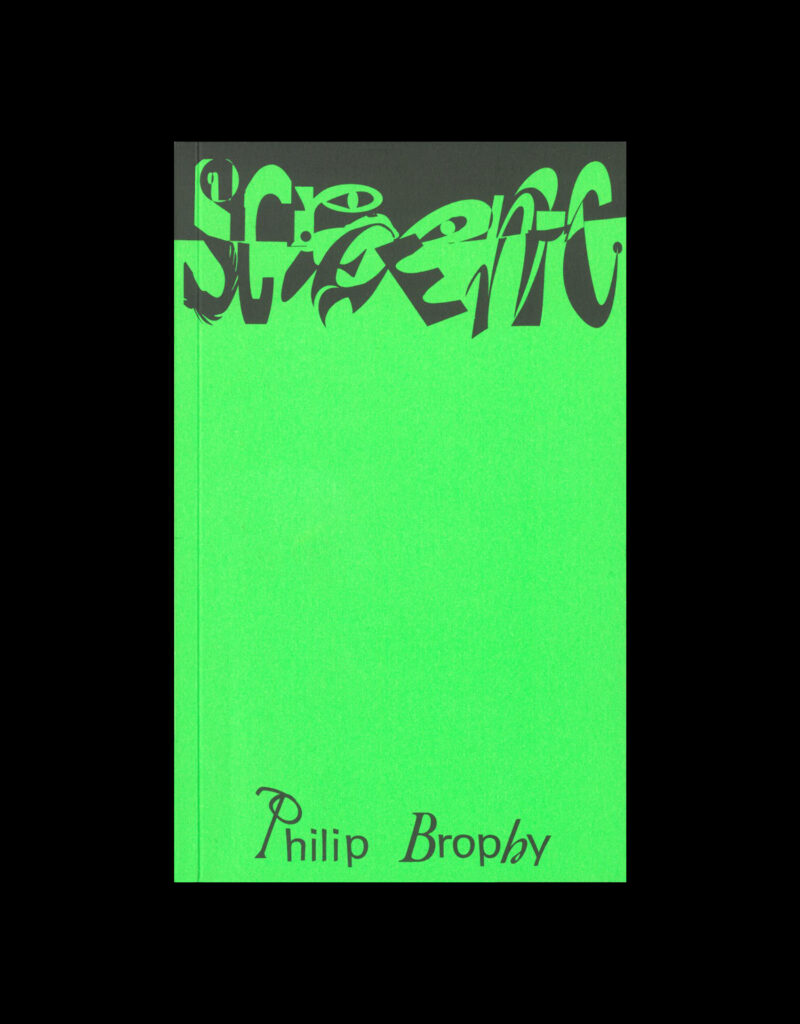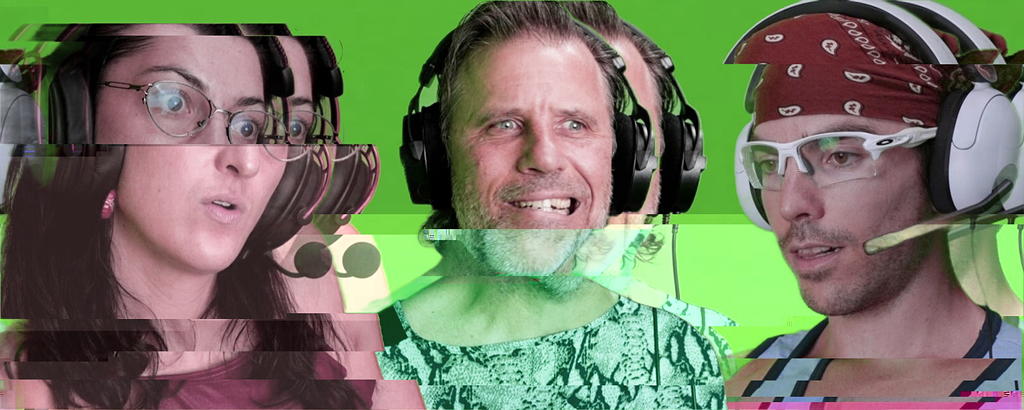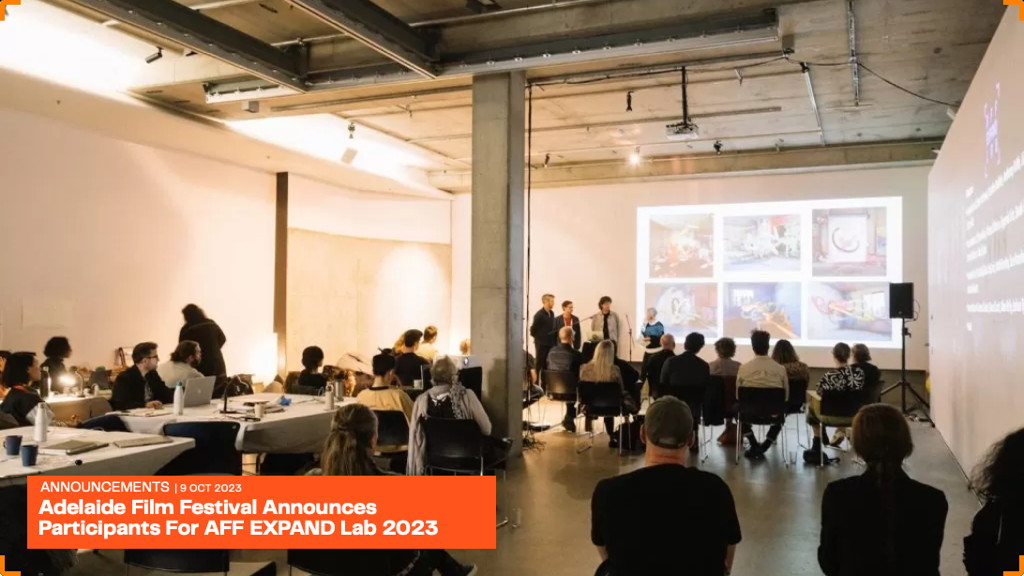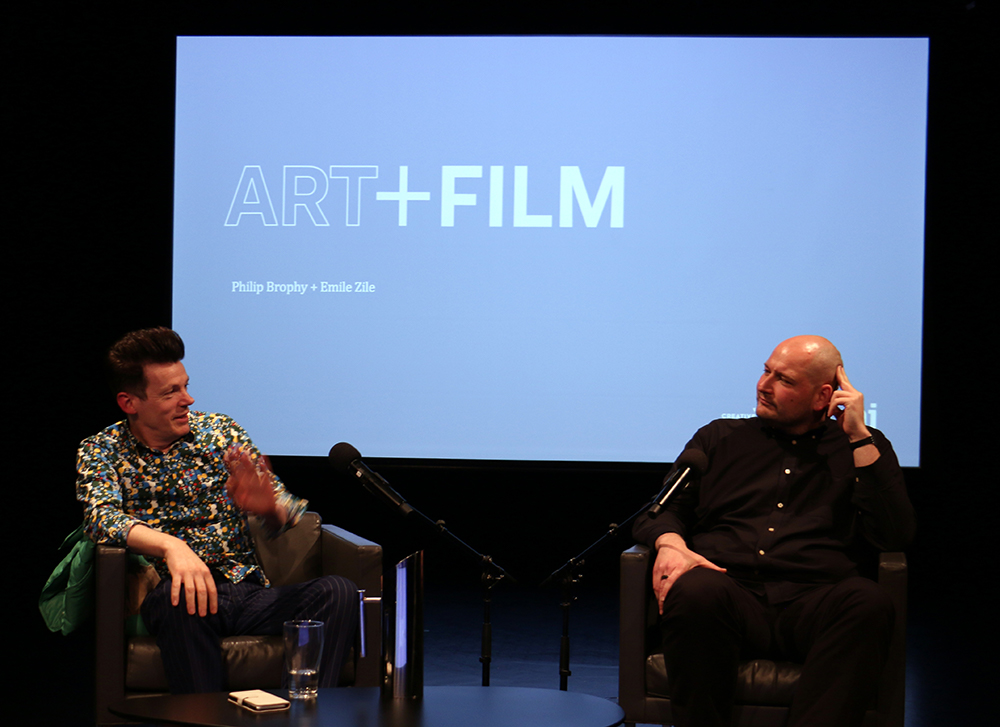
Please join us for a drink to celebrate the launch of Philip Brophy’s new book Screenic. There will be a reading from Emile Zile, and more…
Conners Conners
Fitzroy Town Hall
201 Napier Street Fitzroy
Saturday, November 30, 4-6pm
Emile Zile is an artist, filmmaker and performer.

23 Aug — 16 Nov 2024
RMIT Gallery, 344 Swanston St. Melbourne
Lifting its title from a misheard line in a 1980 song by The Fall about a reclusive dog breeder whose ‘hideous replica’ haunts industrial Manchester, this experimental project—an admixture of artworks, performances, screenings, workshops, a ‘replica school’ and other uncanny encounters—adopts monstrous replication as a tactic, condition and curatorial framework for exploring algorithmic culture, simultaneously alienating, seductive and out-of-control.
Exhibition includes works by Amy May Stuart, Angie Waller, Anna Vasof, Debris Facility, Diego Ramirez, Emile Zile, Joshua Citarella, Liang Luscombe, Loren Adams, Masato Takasaka, Matthew Griffin & Heath Franco and Mo Chu.
Performances, talks and workshops by Catherine Ryan, Chloe Sobek, Jennifer Walshe, Joel Sherwood Spring, Machine Listening, McKenzie Wark, Roslyn Helper, Tomomi Adachi and more.
Curated by Joel Stern and Sean Dockray.
This Hideous Replica has been produced by RMIT Culture and supported by the ARC Centre of Excellence for Automated Decision-Making and Society (ADM+S) and the RMIT Design and Creative Practice Enabling Impact Platforms. This project is a part of the City of Melbourne’s Now or Never festival. This project has been assisted by the Australian Government through Creative Australia, its principal arts investment and advisory body and by the Victorian Government through Creative Victoria.
Image: Mochu, GROTESKKBASILISKK! MINERAL MIXTAPE, 2022, digital video (still), Image courtesy of the artist.
Philip Brophy
Screenic: Politicised Writings on Being Screened
290 pages, softcover, 110 × 180 mm
Edition of 700
ISBN 978-1-7635372-1-7
http://www.discipline.net.au

Discipline is pleased to announce its latest title, Screenic: Politicised Writings on Being Screened—an anthology of Philip Brophy’s writing on art over the last twenty-five years. The focus of the selection is on art that involves screens: projected as film in museums, digitised for installations in galleries, curated as documents within exhibitions, presented as outdoor illuminations on buildings, utilised for the production of VR and AI-generated content, and even wall murals derived from televisual screens. The driver for the writing of these articles is an interest in media literacy within fine art contexts. Together, the articles reinforce the view that ongoing changes taking place in the mediascape over the last two decades create challenges for artists, producers, curators, viewers, and critics—sometimes resulting in a rejuvenation of how media art can be imagined and presented, other times evidencing an anaemic grasp of the contemporary mediascape that whorls outside the white cube.
Screenic has been designed by James Vinciguerra and Duncan Blachford, and printed in Narrm/Melbourne by Documents on Call. It features a preface by Helen Hughes, an introduction by Emile Zile, and has been edited by Olga Bennett.
ACMI Gallery 5 – We Are As Gods
We Are as Gods explores the informal, spontaneous commentary that accompanies cooperative videogame streaming. Through a series of portraits of gamers in the act of live streaming, we hear dialogue that is simultaneously directed at the players themselves, at a remote audience, at a rival player of the game and at anonymous third parties. Using longform recording, stream of consciousness rants and animation, We Are As Gods seeks to find the human in the network, the flesh in the data packet.
Work commissioned through Gallery 5 will enter the ACMI collection.
Many thanks to Senior Curator Fiona Trigg for her focus and patience and Jini Maxwell, Isabella Hone-Saunders at Australian Centre for the Moving Image, Visual FX don Henry Lai-Pyne for being the best in the game, Web maestro Simon Lofler for the clickable NPC streaming interactivity, Flood Slicer for the green screen studio and all Mountain Dew drinkers out there preparing to raid.
Showing now online at ACMI; https://www.acmi.net.au/whats-on/emile-zile-we-are-as-gods/


https://adelaidefilmfestival.org/expand-2023-participants/
Adelaide Film Festival (AFF) announced today the 30 participants selected to take part in AFF EXPAND Lab 2023. This intensive five-day Lab brings together some of Australia’s most creative and inventive artists, filmmakers and XR and VR practitioners in a development and commissioning process to foster new ideas for moving image artworks.
Following a national call for Expressions of Interest, 95 applications were received for the 30 places in the Lab (15 South Australian and 15 national participants). Participants will form teams during the Lab and develop concepts to pitch for the AFF/Samstag $100,000 Moving Image Commission. In addition, two projects will be selected for mentoring by Illuminate Adelaide and the Art Gallery of South Australia.
The mentors for 2023 AFF EXPAND Lab are time-bending digital artist DANIEL CROOKS, theatre maker & media artist ROBERT WALTON, highly respected moving image & film producer BRIDGET IKIN with video artist and filmmaker AMOS GEBHARDT joining as a mentor for the first part of the lab.
AFF EXPAND Lab is an initiative of Adelaide Film Festival with Samstag Museum of Art, Art Gallery of South Australia and Illuminate Adelaide. It is supported by Principal Partner The Balnaves Foundation and Arts South Australia.
Tully Arnot (NSW) – Visual Artist, Media Artist, XR/VR Creator
Max Brading (SA) – Visual Artist, Media Artist, XR/VR Creator
Jake Bresanello (SA) – Visual Artist, Media Artist, Filmmaker
Thom Buchanan (SA) – Visual Artist
Linda Chen (ACT) – Writer, Performer
Marcus Chong (VIC) – Visual Artist, Filmmaker
Chloe de Brito (NSW) – Visual Artist, Filmmaker
Miles Dunne (SA) – Visual Artist, Media Artist
Nisa East (NSW) – Filmmaker, Cinematographer
Deborah Kelly (NSW) – Visual Artist
Isobel Knowles (VIC) – Visual Artist, Media Artist, Filmmaker, XR/VR Creator
Bryce Kraehenbuehl (SA) – Visual Artist, Filmmaker, Videographer
Anna Lindner (SA) – Visual Artist, Filmmaker, Writer
Liang Xia Luscombe (VIC) – Visual Artist, Media Artist, Filmmaker
Chris Luscri (VIC) – Filmmaker
Charlotte Mars (NSW) – Filmmaker
Orlando Mee (SA) – Visual Artist, Media Artist, XR/VR Creator, Games Creative
Conor Mercury (SA) – Filmmaker
Kim Munro (SA) – Media Artist, Filmmaker
Yasemin Sabuncu (SA) – Visual Artist, Media Artist, Videographer, Games Creative
Ryan Sahb (SA) – Visual Artist, Media Artist, Filmmaker, Videographer
Cynthia Schwertsik (SA) – Visual Artist, Performance
Liam Somerville (SA) – Media Artist, Filmmaker, XR/VR Creator, Games Creative
Van Sowerwine (VIC) – Visual Artist, Media Artist, Filmmaker, XR/VR Creator
Will Spartalis (SA) – Visual Artist, Media Artist, Filmmaker, Composer
Kate Vinen (NSW) – Filmmaker
Yandell Walton (VIC) – Visual Artist, Media Artist, XR/VR Creator
Raymond Zada (SA) – Visual Artist, Media Artist, XR/VR Creator
Emile Zile (VIC) – Visual Artist, Media Artist, Filmmaker
I am producing a series of podcast interviews and a live weekend of events for Melbourne Art Book Fair, Melbourne Design Week commissioned by the National Gallery of Victoria. Full event program below, the live event will be streamed via NGV website.
https://www.ngv.vic.gov.au/program/event-print-screen-new-publishing-now/
Podcast audio production by Carl Anderson, Graphic Design by Lauren Messina
Melbourne artist Emile Zile hosts a podcast series and live event for Melbourne Art Book Fair and Melbourne Design Week at the NGV.
Looking at the state of alternate publishing and new forms of distribution, PRINT SCREEN will host discussions on the widespread disruption of traditional media channels and the accelerating digitisation of shared cultural consumption. Via podcast and live forum PRINT SCREEN will open up a vital discussion on the new waves of publishing and promotion that are located in simultaneously public and private realms.
What are the possibilities for new forums of cultural dispersion? Is there any escape from software after Covid? Where is the new gatekeeper? Who is making new claims? Is this moment of destabilisation a significant opportunity to reimagine publishing?

Saturday 27 March – Great Hall, NGV International
12-1.15pm
Newsletter DJ (Tiesto) LG Hill
Christopher LG Hill plays his newsletter live and direct, chopping download links and slinging .zip archives. Taking his esoteric and wide-ranging email newsletter as a starting point, Melbourne artist, publisher and musician LG Hill flips the great (dance)hall on its ear for Melbourne Art Book Fair.
Listen to Emile Zile interview Chris at Print Screen podcast.
https://disclaimer.org.au/contents/one-year-of-a-link-based-email-newsletter
https://printscreen.simplecast.com/episodes/christopher-lg-hill
1.30-2.45pm
NFT fireside chat with Joe Hamilton and Nic Hamilton
Digital Artists Joe Hamilton and Nic Hamilton talk about their individual video practices and the newest category of commercial art, the NFT. Join us for a jargon-free primer for those curious about all that is non-fungible.
Followed by audience Q+A
https://foundation.app/joehamilton/hyper-geography-7426
https://www.nichamilton.info/collection
Sunday 28 March – Great Hall, NGV International
12-1.15pm
Digital Self-Publishing with Amelia Winata, Diego Ramirez and Anador Walsh
Art Criticism is migrating online, join leading local writers and editors to discuss digital art criticism, self-publishing and the challenges and limitations of being very online.
With Amelia Winata of MeMO review, Anador Walsh of Performance Review, Diego Ramirez of Running Dog
Followed by audience Q+A
https://memoreview.net/
https://www.performancereview.online/
https://rundog.art/
1.30-2.45pm
Static Bodies, Networked Bodies with Shian Law, Lilian Steiner, Harrison Hall and Sam Mcgilp
During COVID-19 dancers found new ways to move. How did dancers and choreographers publicise and distribute themselves under pandemic conditions? What was learnt in the great pivot to digital, what is to be kept? What is to be left in 2020?
Followed by audience Q+A
With Shian Law, Lilian Steiner. Harrison Hall and Sam Mcgilp
https://www.ngv.vic.gov.au/melbournenow/artists/shian-law.html
https://harrisonhall.com.au/
https://www.sammcgilp.com/
http://www.liliansteiner.com/
Panel discussion with Amrita Hepi and Angela Goh on the networked body, new intimacies, post-Isolation psychologies and the what it means to make digital art.
https://apam.org.au/event/local-player-arts-house/
Listen to Arts House Artistic Director Emily Sexton in a panel discussion with artists Amrita Hepi, Angela Goh and Emile Zile on new practices that focus on the intersection between live and digital forms, and what this can mean for new partnerships, touring and residency approaches. What is the live experience in a contemporary world where the relationship between on- and offline is totally blurred? How is performance reckoning with the rise of the Golden Age of streaming television? How is the intimacy of watching performance in a dark room with strangers shifting?
BLEED Echo is a public program responding to and ricocheting from the five artist projects and curatorial conversations of BLEED.
My work with Lilian Stiner ‘Becoming The Icon’ will premiere at Bleed in August 2020.
Check bleedonline.net for more info.
https://www.li-ma.nl/lima/news/unfold-audienceperformermirror
On the 15th of January 2020 LIMA invites Keren Cytter, Jan Robert Leegte and Emile Zile to present their version of Dan Graham’s performance and video work Audience/Performer/Mirror. Reinterpretations by Adad Hannah, Ian Forsyth & Jane Pollard, and Judith Hopf will be exhibited as well.The works together show the possibilities of reinterpretation and give an artistic anthology, and criticism, of the work of Graham. Gabriella Giannachi (researcher & professor of Performance and New Media at the University of Exeter), Annet Dekker (curator & researcher, assistant Professor of Media Studies University of Amsterdam) and Willem van Weelden (curator & researcher, tutor media theory Gerrit Rietveld Academie,) will reflect upon reinterpretation as both an artistic as preservation strategy. Moderated by art historian & dramaturgist Suzanne Sanders.
New light on iconic work
LIMA presents a new edition of UNFOLD, focusing on reinterpretation and Dan Graham’s iconic work Audience/Performer/Mirror, 1977, De Appel, Amsterdam. During this performance, Graham describes his own actions and the reaction of the audience. The work is questioning who or what motivates who to act and respond and is a reflection on time and direct feedback. All of this happens largely through language: Graham’s flow of words is unceasing, and betrays his background in stand-up comedy. The gaze of the camera, in addition to that of Graham and the mirror, plays an important role in this. The work is effective and layered in all its simplicity and has become an iconic work. The analogy that Graham uses in the work, both at the level of technology and that of language and physicality, has invited many artists to make a homage or a new version of the work. What does Audience / Performer / Mirror stand for today? How is the work experienced; which part of the work is still relevant, what needs to be ‘updated’? LIMA invites Jan Robert Leegte and Emile Zile to translate the work to contemporary time and its digital techniques. Keren Cytter is invited to present her subtle feminist critique on the work. UNFOLD: Audience/Performer/Mirror offers the opportunity to think about reinterpretation and provides insight into both their working methods and the lasting (attraction) power of Dan Graham’s work. This core may be somewhere else for every artist, and each new work will highlight a different aspect of the ‘original’.
About UNFOLD
Reinterpretation is a core concept in music, dance and theater. Every re-performance is a translation into a new, often contemporary, context. Re-performing a work based on documentation, a script, memory or score is an essential part of artistic practice. For complex works in the field of media art and digital art, this is not common, but just as urgent. Reinterpretation of media art can contribute to the preservation and better understanding of the work. Since 2016, LIMA has put reinterpretation on the map as an artistic and conservation strategy. In the interdisciplinary and international UNFOLD project contextualizing, documenting, analyzing, understanding, embodiment and transferring digital culture are central. Relevant questions are: What is the core and production method of a work? Which techniques are used in which context? How do we translate this artistic legacy, practice and knowledge to the next generation? How do reflect and learn from different interdisciplinary practises?
Programme
5 pm Doors open
5.30 – 6.15 pm Presentation Rietveld Students (*free entrance)
6.30 pm Opening exhibition (in collaboration with De Appel): Dan Graham’s iconic work and documentation material of Audience/Performer/Mirror, 1977 De Appel, Amsterdam. Reinterpretations by Adad Hannah, Performer Audience Remake, 2008; Ian Forsyth & Jane Pollard, Audience Performer Fuck Off, 2009, Judith Hopf, What Do You Look Like / A Crypto Demonic Mystery, 2006. (*free entrance)
6.30 – 9 pm Performances Keren Cytter (Performer/Audience/Mirror, 2012), Miron Galić reenacting Cursor, 2016 in Jan Robert Leegte’s Mirror (2020) and Emile Zile (Performer/Audience/Lens, 2018) + artist talks followed by a panel discussion with: Gabriella Giannachi, Annet Dekker and Willem van Weelden moderated by Suzanne Sanders (*a ticket is required for this part of the program).
Event
UNFOLD: Audience/Performer/Mirror
With works and contributions by Dan Graham, Keren Cytter, Emile Zile, Jan Robert Leegte, Gabriella Giannachi, Annet Dekker, Willem van Weelden, Adad Hannah, Ian Forsyth & Jane Pollard, Judith Hopf and students from the Rietveld Academy.
Wednesday 15 January, 2020
5 pm Doors open
5.30 – 6.15 pm Presentation Rietveld Students (free entrance)
6.30 pm Opening exhibition (free entrance)
6.30 – 9 pm Performances & artist talks Keren Cytter, Jan Robert Leegte and Emile Zile, followed by panel discussion (a ticket is required for this part of the program)
Entrance: € 7,50 / 5,- /Free with Cineville
LIMA/LAB111, Arie Biemondstraat 111, Amsterdam
Language: English
Facebook event
Exhibition
UNFOLD: Audience/Performer/Mirror (in collaboration with De Appel)
With works by Dan Graham, Adad Hannah, Ian Forsyth & Jane Pollard and Judith Hopf.
15 – 22 January 2020
Every day from 12 – 23 pm, entrance is free
LIMA/LAB111, Arie Biemondstraat 111, Amsterdam
Graphic design by Bin Koh.
UNFOLD Audience/Performer/Mirror is supported by De Appel, Rietveld Academie and the Mondrian Fund and is part of the collaborative research project Documenting Digital Art, supported by the Arts & Humanities Research Council.
In late May I will be in Los Angeles for the Saas-Fee Summer Institute of Art at Otis College of Art and Design Los Angeles.
— Art and Politics in the Age of Cognitive Capitalism —
http://saasfeesummerinstituteofart.com
Saas-Fee Summer Institute of Art (SFSIA) is a nomadic, intensive summer academy with shifting programs in contemporary critical theory academy that originated in Saas Fee, Switzerland in 2015 and moved to Berlin in 2016. SFSIA stresses an interdisciplinary approach to understanding the relationship between art and politics. This year, in addition to the Berlin academy, we are hosted in Los Angeles by Otis College of Art and Design with participation of the MA Aesthetics and Politics in the School of Critical Studies at CalArts.
The academy was founded by fine artist and theorist Warren Neidich, is co-directed by art critic and poet Barry Schwabsky. Sarah Beadle is Director of Administration. It was conceived in 2014 as part of an ongoing effort to engage contemporary artists in political, socio-economic, philosophical and historical discourses concerning the power of art. Importantly it realizes that art plays both a generative and emancipatory role in producing theory while at the same time being aware of Neoliberal capitalism’s recuperative prowess.
The program runs two weeks and is structured with half-day seminars, deep readings, and workshops. In the evening SFSIA holds a lecture series, which is open to the public.
Faculty
Alva Noë, Andrew Culp, Arne De Boever, Barry Schwabsky, Candice Lin, Ed Finn, Eleanor Kaufman, Florencia Portocarrero, Graham Harman, Jason Smith, Jennifer Teets, Johanna Drucker, John C. Welchman, Juli Carson, Kenneth Reinhard, Mary Kelly, N. Katherine Hayles, Nima Bassiri, Renee Petropoulos, Reza Negarestani, Sanford Kwinter, Suparna Choudhury, Warren Neidich.
Join Emile Zile and Philip Brophy for a conversational and unmoderated exchange as they select, screen and discuss each other’s video work. Both artists move horizontally between visual art, filmmaking and performance, working beyond the confines of strict categorisation. Their methods and tools are post-cinematic: scavenging and re-presenting the moving image material that surrounds them.
11 September 2017, 6.30pm
Free entry, bookings requested
Australian Centre for the Moving Image, Federation Square Melbourne
https://www.acmi.net.au/events/emile-zile-and-philip-brophy/


